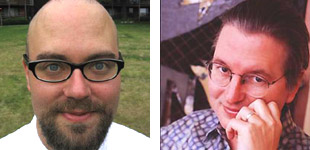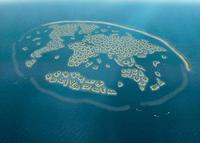 Very nice set of notes at WorldChanging about a speech Bruce Sterling and Alex Steffen gave at the SXSW conference a few weeks ago, where they ran through a bunch of big global problems and possible sustainable and technological solutions to them. A few of the concepts discussed: Very nice set of notes at WorldChanging about a speech Bruce Sterling and Alex Steffen gave at the SXSW conference a few weeks ago, where they ran through a bunch of big global problems and possible sustainable and technological solutions to them. A few of the concepts discussed:
- Protocrats: Who will be creating a sustainable future, and what will we call them? "There's an electronic conjulation of smaller groups that are living in one another's laps, trading info across institutional boundaries, move things fast and punting developments into mass consumption," Bruce said. He calls these people "protocrats" - green designer/instantiators ahead of the curve on developing new technologies, pushing them beyond labs and into mass development.
- Alex introduced a range of concepts that will be familiar to WC readers, but were new to much of the SXSW audience, including ecological footprinting; urban design and green megacities; and the sharing of objects and resources, known as product- service systems.
- Bruce looked at three approaches to making objects sustainable:
1. Neobiology and biomimetics: when you lose it, it rots.
2. Build monuments for the ages. Abandon fashion. It'll be artsy and craftsy, roughhewn and honest - but you don't get to change your mind about it.
3. Label everything in the environment and digitally track it. Give everything a unique identity, and make the bar code searchable. Track it throughout its lifetime, from manufacture to disassembly and material recovery. When it breaks, push a button and somebody picks it up. This is the Internet of Things. It would require plenty of bandwidth, tracking, extensive databases, and (of course) a remake of the entire social, legal, and economic system, "which happens all the time". - Leapfrogging: Under certain conditions, people who are technologically underdeveloped might skip a stage and jump to the next, newer technology (see Jamais' "Leapfrogging 101").
- Treefrogging: The emergence of bright green solutions for personal use, as outlined by WC allies Metaefficient and Treehugger. Distinct from LOHAS-type alternatives (Lifestyles of Health and Sustainability, as typified by Whole Foods, or Natural Home Magazine), this is the creation and distribution of new design concepts. As with the Solar Backpack concept that Bruce test-drove for Treehugger, good ideas can now be picked up and produced on demand. "Throw it over the side to the piranhas of bloggerland!"
- Monitoring: In cities: for checking emissions, controlling traffic on highways. Don't expect drivers to do all the navigation. In the human body: monitoring bioaccumulation of lead, or jet fuel, in your cells. "What if the shower told you that you've got a suspiciously large amount of jet fuel in your body today? You'd wonder who the hell spilled the jet fuel." Of objects: material composition, location, off-gassing, pollution; the double-edged sword of RFID tagging and tracking of objects.
[ Information | 2005-04-07 13:17 | | PermaLink ] More >
|
 The formerly very isolated kingdom of Bhutan is working on a new constitution. The draft is rather beautiful. It starts out like this:
The formerly very isolated kingdom of Bhutan is working on a new constitution. The draft is rather beautiful. It starts out like this: Very nice set of notes at WorldChanging about a speech Bruce Sterling and Alex Steffen gave at the SXSW conference a few weeks ago, where they ran through a bunch of big global problems and possible sustainable and technological solutions to them. A few of the concepts discussed:
Very nice set of notes at WorldChanging about a speech Bruce Sterling and Alex Steffen gave at the SXSW conference a few weeks ago, where they ran through a bunch of big global problems and possible sustainable and technological solutions to them. A few of the concepts discussed:
 "The World" is a group of 300 artificial islands constructed off the coast of Dubai, shaped to look like a map of the world when seen from above. The development covers an area 9km by 6km and there's 50-100 meters between islands. Connected with water taxis, patrolled by a Beverly Hills type police force. The islands are for sale for private estate homes, resorts, golf courses, or whatever you might have in mind. Your imagination is the limit. Well, that's what so bizarre. It seems so very virtual. Just like buying an island in some online virtual world. You want a fairy tale castle, a rain forest - go ahead. The main difference is that the cheapest island here is around $7 million, and that's without the cost of whatever it is you might imagine.
"The World" is a group of 300 artificial islands constructed off the coast of Dubai, shaped to look like a map of the world when seen from above. The development covers an area 9km by 6km and there's 50-100 meters between islands. Connected with water taxis, patrolled by a Beverly Hills type police force. The islands are for sale for private estate homes, resorts, golf courses, or whatever you might have in mind. Your imagination is the limit. Well, that's what so bizarre. It seems so very virtual. Just like buying an island in some online virtual world. You want a fairy tale castle, a rain forest - go ahead. The main difference is that the cheapest island here is around $7 million, and that's without the cost of whatever it is you might imagine.